#Mozarteum
Explore tagged Tumblr posts
Text
How to Dank Images – Methoden der Bildanalyse im Kontext des visuellen Kontrollverlusts
Das Worklab HOW TO DANK IMAGES schließt an das Worklab ‘Dank Images, Tiktok und Apokalypse. Bildhandeln im Internet’ an und extrapoliert die in 2021 identifizierten Diskurse und Leerstellen, die auf ein komplex(er)es Verständnis gegenwärtiger politischer, sozialer und medialer Kommunikation zielen. Ausgehend von der Annahme, dass neuartigen Bildphänomenen Raum gegeben werden muss, unternimmt das Worklab eine methodische Sondierung und Sammlung von Praktiken des Forschens. Denn gerade (Online-)Bilder kommunizieren über unzählige Formen des Alltäglichen und kommentieren politische und gesellschaftliche Ereignisse in Echtzeit. Insbesondere Krisenszenarien befeuern dabei die Bildproduktion und lassen z. B. Memes zu politischen Akteur*innen werden, die besondere Aufmerksamkeit in der Analyse und Diskussion erfahren, und angepasste Methoden erfordern.
Das Worklab fand am 27.&28.10.2023 online statt und näherte sich dem Forschungsthema experimentell über verschiedene offene Austauschformate, partizipative Explorationsräume, sowie Kurzinputs der Teilnehmenden.
WEB: http://kunst.uni-koeln.de/dankimages


#kunstpaedagogik#mozarteum#arteducation#jangruenwald#jangrünwald#kunstuniköln#zoom#dankimages#medien
0 notes
Text
#Wolfgang Amadeus Mozart#unknown piece#discovered#Leipzig#Salzburg.#International Mozarteum Foundation
2 notes
·
View notes
Text

Unknown Mozart Music Discovered in Germany
A previously unknown piece of music likely composed by a teenage Wolfgang Amadeus Mozart was recently uncovered at a library in Germany.
The piece, which dates to the mid- to late-1760s, consists of seven miniature movements for a string trio. It lasts around 12 minutes, researchers with the Leipzig Municipal Libraries said in a statement.
Researchers discovered the work at the city's music library while compiling the latest edition of the so-called Koechel catalog, the definitive archive of Mozart's musical works.
The piece is referred to as "Ganz kleine Nachtmusik" in the new Koechel catalog, according to the Leipzig libraries.
The Koechel catalog describes the piece as "preserved in a single source, in which the attribution of the author suggests that the work was written before Mozart's first trip to Italy", according to the municipal libraries.




The newly discovered manuscript, which consists of dark brown ink on medium-white handmade paper, was not penned by Mozart himself but is believed to be a copy made around 1780, the researchers said.
The young Mozart had been known to researchers up until now "mainly as a composer of piano music, arias and symphonies", Ulrich Leisinger of the International Mozarteum Foundation in Salzburg said in a statement.
A list by Mozart's father had alerted academics to the existence of "many other chamber music compositions" by the young artist, which were all thought to have been lost until the emergence of the string trio, Leisinger said.
"Since the inspiration for this apparently came from Mozart's sister, it is tempting to imagine that she kept the work as a memento of her brother," Leisinger said.
Born in 1756, Mozart was a child prodigy and began composing at a very early age under his father's guidance.
The piece was performed by a string trio at the unveiling of the new Koechel catalog in the Austrian city of Salzburg on Thursday. It will receive its German premiere at the Leipzig Opera on Saturday.

#Wolfgang Amadeus Mozart#Unknown Mozart Music Discovered in Germany#Leipzig Municipal Libraries#Ganz kleine Nachtmusik#music#music composer#art#artist#art work#art world#art news#history#history news#lost and found
48 notes
·
View notes
Text

MOZART: AT THE GRAVE
The untimely death of Wolfgang Amadeus Mozart on December 5, 1791, at the peak of his artistic prowess, silenced the detractions and jealousy of his critics. It elevated his reputation among those who understood the magnitude of his loss. His death elicited widespread public sympathy, particularly for his bereaved family, who were left in financial need. This sympathy translated into generous support not only in Vienna and Prague but also in other cities visited by his widow, Constanze, during her professional tours.
EFFORTS TO SUPPORT CONSTANZE AND HER FAMILY
In 1796, during a visit to Berlin, Constanze received support from Frederick William II, who allowed her to use the opera house and royal musicians for a benefit concert. She performed as a vocalist at this event (February 28). The concert program noted the king’s esteem for Mozart's talent and his regret that Mozart had not been able to reap the full rewards of his work. Despite such efforts, these initiatives were insufficient to provide long-term financial security.
In 1799, Constanze sold all the manuscripts in her possession to the publisher André for 1,000 ducats. While this sale brought immediate relief, some manuscripts had already been lost or gifted, and the André collection itself was later dispersed, depriving public institutions of a complete archive of Mozart's work.
CONSTANZE’S SECOND MARRIAGE
Constanze secured a stable future through her second marriage to Georg Nikolaus Nissen, a Danish diplomat, in 1809. Nissen, whom she met in 1797, proved to be a devoted supporter, helping her manage her affairs and raise her children. After resigning from his diplomatic career in 1820, Nissen settled with Constanze in Salzburg, where they lived alongside Mozart’s sister, Nannerl. Nissen passed away in 1826, and Constanze died on March 6, 1842, shortly after the arrival of a model for a Mozart statue in Salzburg.
MOZART’S CHILDREN
Karl Thomas Mozart (1784–1859):
Karl pursued careers as a merchant, musician, and eventually a minor government official in Milan. He was an accomplished pianist but did not achieve widespread recognition.
Franz Xaver Wolfgang Mozart (1791–1844):
Known as Wolfgang Jr., he became a professional musician, achieving moderate success as a pianist and composer. However, his father’s towering legacy overshadowed his career. He held positions as a musical director in Lviv (Lemberg) and later in Vienna.
POSTHUMOUS RECOGNITION AND MEMORIALS
Mozart’s legacy was celebrated widely after his death:
Anniversaries and Concerts:
His works and commemorative funeral cantatas were performed in numerous cities. Significant anniversaries of his birth and death continue to be honored with concerts worldwide. The centennial of his birth in 1856 was marked by extensive celebrations across Germany and beyond, spurring renewed interest in his compositions.
Monuments and Statues:
In 1799, Duchess Amalie of Weimar erected a terracotta memorial in Siefurt featuring a lyre and theatrical masks.
A grand statue of Mozart was unveiled in Salzburg on September 4, 1842, sculpted by Schwanthaler. While the statue reflects Mozart's artistic dignity, some critics argue it lacks idealized force.
In Vienna, a monument designed by Hans Gasser was installed in St. Marx Cemetery on December 5, 1859, featuring a mourning muse holding the score of the Requiem.
Institutions and Societies:
The Salzburg Mozarteum, founded in 1842, preserves important family documents and promotes music, particularly sacred music.
The Mozart Institution in Frankfurt, established in 1838, supports young musicians through prizes and scholarships.
A Mozart Society, founded in 1855, aids struggling musicians.
MOZART’S LEGACY
Mozart’s true and enduring fame lies in his works. His compositions influenced countless successors, providing a foundation for both innovation and imitation. His artistic genius bridged the traditions of his era with the possibilities of the future, inspiring every composer who followed.
COMPARISONS AND CHARACTER
Mozart’s artistry has often been compared to other great figures, notably:
• Raphael for his harmonious and majestic beauty.
• Shakespeare for his dramatic creativity and humor.
• Goethe for his clarity of sentiment and depth of human expression.
Despite these parallels, Mozart’s individuality remains unparalleled in music. His works exhibit universality and truth, transforming human emotion into music with unmatched authenticity. His legacy embodies the profound joy of artistic achievement and the purity of his creative spirit.
FINAL REFLECTION
Mozart’s life, though marked by hardship and untimely death, is a testament to the power of artistic genius. His contributions to music are eternal, and his name stands among the greatest in history. As his countrymen might say, “And he was one of us!”
(Portrait of Franz Xaver Wolfgang (1791-1844) and Karl Thomas (1784-1858), sons of Wolfgang Amadeus Mozart (1756-1791), Painted by Hans Hansen (1769-1828))
Thank you Alex Rosas Navarro FB @ Mozart Group
#mozart#mozart life#wolfgang amadeus mozart#classical composer#classical history#classical music#classical art#classical instruments#18th century#classical
9 notes
·
View notes
Text



Photo Above: Mozart’s Violin
Photo Below: Mozart’s Viola
The violin is more or less in its original state. It was built in Mittenwald, a community located 60 miles south of Munich, along an important trade route to Italy. It established itself as a very important center of violin making in the final decades of the 18th-century. The Mozart concert violin was most likely built by a member of the violin-making family Klotz, and was built in 1700 or a bit later. The Mozarteum Foundation bought it in 1956, ten years before we bought the viola. The violin is really a remarkable document of what Mozart understood of the violin sound—[it] really gives a big picture and a very good impression of how he felt the sound and how he heard it. It’s really in a very good and original condition.
These instruments give us a good idea of what sound Mozart himself had in mind when writing, let's say, his violin concertos and Sinfonia Concertante. There were no loud, romantic sounds: Everything was incredibly intimate. For one, because the instruments were small and strung with gut strings, and for two, Mozart would not have played in large halls, ironically, where many performances of his music are being played today. Actually, *Mozart refused to perform on his violin in public at all, which might have been due to his not practicing the instrument, which his dad scolded him in letters for. He premiered his Sinfonia Concertante on viola*
The earliest evidence for the violin is a certificate by Marie Trestl from August 1842, stating that the instrument had been acquired by her father, Leopold Trestl in 1820 from Mozart’s sister, Nannerl Mozart. Around 1879 the instrument was in the personal possession of Adalbert Lenk—he was a violin professor at the Mozarteumand the violin remained in private possession until it was acquired by the Mozarteum Foundation in 1956—we bought it from the family of Josef Brandner. The fact that the instrument was not modernized in the 19th century makes it clear that it was regarded as a relic early on. So it is really in a very very good shape. And if you come to the Boston Early Music Festival where we will present the instruments, we will have a baroque violinist, Amandine Beyer, and you really can hear it in a fantastic situation, in a trio, and it gives a great impression of the sound of Mozart’s time.
These instruments get us much closer to hearing what Mozart himself had in his head when he was composing, though until somebody invents a time machine, that's about as far as we are going to get.
Maybe a working flux capacitor is somewhere in the near future ..👨🔬?
The viola has a remarkably warm tone, but has probably lost some of its former volume as a result of the adaptation of its size, but it’s a really very nice-sounding instrument. It was reduced to standard size during the 19th-century by cutting off the margins of the top and back considerably. It is assumed that the instrument originally was at least 13mm longer. At the same time, the original scroll was replaced by a new one taken from a German or Austrian instrument.
Hear Mozart’s instruments played here 👇
Live in concert in the WGBH Fraser
Performance Studio, violinist Daniel Stepner and violist Anne Black get a once-in-a-lifetime opportunity to perform a work by Mozart on instruments that the composer himself owned and played. From Classical New England's "Mozart Comes to America" special, produced in conjunction with the Salzburg Mozarteum Foundation (owner of the instruments) and the Boston Early Music Festival, Stepner and Black play the Finale of the Duo in G, K. 423, by Mozart.
🎶 🎻 🎵 🎻 🎶 🎻 🎵 🎻 🎶 🎻 🎵
youtube
#mozart#classical instruments#classical music#art#18th century#classic#classical history#classical art#classical musician#classical composer#violin#viola#classical#a classical life#music video#Youtube
12 notes
·
View notes
Text


















Jiří Kolář
Gerwald Sonnberger, Egon Schiele Centrum Český Ktumlov
Galleria Nazionale d'Arte Antica Palazzo Barberini, Roma 1998 , 140 pages, 21x29,5cm,
euro 80,00
email if you want to buy [email protected]
Mostra Galleria Nazionale d'Arte Antica Palazzo Barberini Roma 21 maggio-28 giugno 1998 nell'ambito della mostra Jiří Kolář e il Collage Ceco
Jiří Kolář nasce nel 1914 a Protivín in Boemia. Nel 1922 si trasferisce a Kladno vicino a Praga. Dopo un’adolescenza caratterizzata da lavori fortuiti, a sedici anni scopre l’edizione ceca di “Les mots en liberté futuristes” di Filippo Tommaso Marinetti, che lo conduce nel mondo della poesia moderna, fondamentale per la sua futura ricerca artistica. Grazie all’incontro con il Surrealismo inizia a lavorare con la tecnica del collage. Nel 1937 espone per la prima volta al Mozarteum di Praga. Nel 1941, durante l’occupazione tedesca, esce la sua prima raccolta di poesie e l’anno seguente fonda il “Gruppo 42” insieme ad altri artisti. Tra il 1946 e il 1948 compie alcuni viaggi a Parigi, in Germania e in Gran Bretagna e qualche anno dopo esce Il Fegato di Prometeo (1952) nel quale, unendo le immagini alla poesia e alla prosa, denuncia la drammatica situazione cecoslovacca dopo l’avvento del regime comunista; una dura verità che insieme ad altri scritti gli costa il carcere per nove mesi e il divieto di pubblicazione fino al 1964. Verso la fine degli anni Sessanta espone in Germania e in Brasile dove nel 1969 è premiato alla X Biennale di San Paolo quindi in Canada e in Giappone. Nel ‘75, nel ‘78 e nell‘85 il Solomon R. Guggenheim Museum di New York gli dedica tre importanti mostre personali (Kolář e Picasso sono gli unici artisti che, da viventi, hanno avuto l’onore di tre mostre personali presso il Guggenheim di New York). Seguiranno molte altre esposizioni in tutto il mondo. Nel 1983 conclude il “Dizionario dei metodi”, una raccolta con tutte le tecniche utilizzate per la realizzazione delle sue opere: collage, ventilages, chiasmages, confrontages, etc. Le sue opere sono presenti nei maggiori musei del mondo. Nel 1991 riceve il Premio Seifert e viene nominato cittadino onorario di Praga, dove muore nell’agosto del 2002.
É del 2012 un’importante retrospettiva presso il MOCAK di Cracovia, mentre nel 2014 si è tenuta una mostra antologica presso la Kunstforum Ostdeutsche Galerie di Regensburg, in Germania ed una mostra-tributo in onore del centenario della nascita dell’artista (September 23, 2014 – February 8, 2015) presso il Museum Kampa di Praga.
L’anno successivo una mostra antologica con più di 160 lavori gli è stata dedicata a Prato presso la Galleria Open Art ed il museo di Pittura Murale di San Domenico.
14/12/24
5 notes
·
View notes
Text

Friday, 12-06-24, 8am Pacific
G'Mornin' everyone, Mr. Baggins here with our Morning Coffee Music. While I finish making the coffee happen here, we'll hear our daily three Preludes and Fugues, played on harpsichord by Malcom Hamilton. Today we hear Nos. 19, 20, and 21 from Book 2 of WTC.
youtube
youtube
youtube
Ah, that always helps the old synapses start firin'! We'll hear a little more Bach later, but right now we'll be hearing another of Mendelssohn's String Symphonies, this time Number 4, with Nicholas Ward conducting the Northern Chamber Orchestra.
youtube
Hard to believe he wrote these when he was 12! Next let's hear another child prodigy, Mozart. We hear his Divertimento No. 11 in D Major, K. 251, played by Camerata Academica des Mozarteums Salzburg (Camerata Salzburg), Sándor Végh conducting.
youtube
And now, from the next video's descriptive notes: "This extremely rare 1956 recording features Mason Jones (french horn), Anthony Gigliotti (clarinet), John deLancie (oboe), Sol Schoenbach (bassoon), and William Kincaid (flute) in a performance of Haydn's Divertimento No. 1 in B flat major." Couldn't have said it better m'self!
youtube
Now let's hear the music of Czech (Bohemian) composer Joseph Suk (who was Dvorak's son-in-law), his Serenade for Strings in E-flat Major, Op. 6., performed by the Czech Philharmonic Orchestra conducted by Jiří Bělohlávek.
youtube
And here is the Piano Concerto No. 2 of Czech composer Bohuslav Martinu. Rudolf Firkusny is the soloist with Carlo Maria Giulini conducting the New York Phil in a recording made in 1968.
youtube
Now let's hear Horowitz in the last of Chopin's Scherzos, the Scherzo No. 4 in E major, Op. 54. Recorded in London at Abbey Road Studios in 1936!
youtube
We've got one more work this morning, something to get us on our way to the rest of the day, and that little bit more Bach I promised you earlier. Let's check in with Glenn Gould and hear him with Golschmann and the Columbia do Bach's Concerto No. 5 in F minor, BWV 1056.
youtube
And that wraps up our Morning Coffee Music for this Friday! I do hope you've enjoyed the selections this morning and possibly heard something new to your ear. This is Mr. Baggins signing off for now, I'll be back at 2pm with our Afternoon Stack of Classic Wax!
Until then, be kind, babies, be kind.
Baggins out.

4 notes
·
View notes
Text
youtube
Jules Massenet (1842-1912) - Cendrillon, Act 2: "Allez, laissez-moi seul" - Air. "Cœur sans amour, printemps sans roses" (Le prince charmant)
Mezzo- Soprano Vocals: Marianne Crebassa
Orchestra: Mozarteum Orchester Salzburg, Conductor: Marc Minkowski
4 notes
·
View notes
Text
Olá São Paulo! It is so wonderful to be here 🇧🇷 I was so humbled to see everyone at our last concert at Sala São Paulo the other night! You were all incredibly welcoming - I was very touched 🥰 We have one more concert here tomorrow with the fantastic Orquestra Acadêmica Mozarteum Brasileiro and I hope to see you there!!
7 notes
·
View notes
Text
Wenn Ivo doch auf Franz' Musikgeschmack kommt ;)
War gerade bei einem musikalischen Abend mit Miro und es war großartig! Wer es nicht weiß: ja, der gute Herr Nemec ist am Mozarteum ausgebildeter Musiker!
12 notes
·
View notes
Text
Tagung: CRINGE OR WORTHY – Lebenswelten in Kunst- und Musikpädagogik
Mit Kolleg*innen aus Salzburg habe ich eine Tagung über die Relevanz von Jugendkulturen für die Pädagogik organisiert...die (unserer Meinung nach) ein voller Erfolg war :)
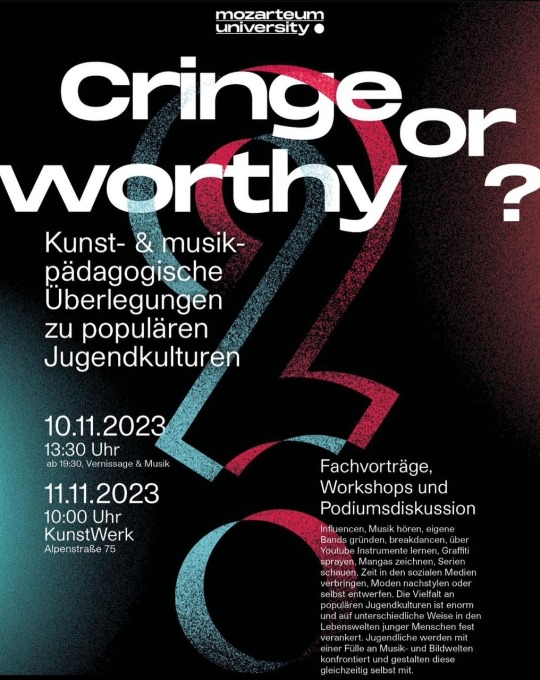

0 notes
Text
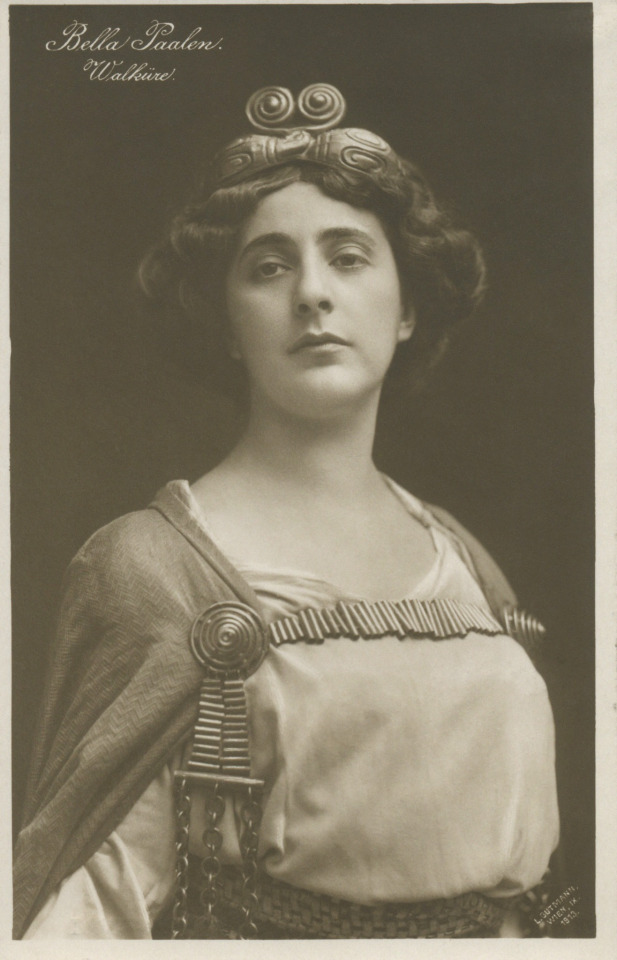
Bella Paalen as Fricka; Vienna, 1919
Bella Paalen was born as Isabella (Izabella) Pollak in Pásztó, Komitat Nógrád, in Austro-Hungarian Hungary on December 9, 1881. She was the oldest of the three children of a Jewish couple – Laura Pollak neé Jamnitz, and Ernst Pollak. Ernst was initially a factory director, and later a representative for commercial trade agencies. The Pollaks lived in the Austro-Hungarian capital and Imperial Residence city of Vienna.
Isabella Pollak studied voice at the Conservatory of the Society of Friends of Music. Her voice teacher was a prominent interpreter of Richard Wagner’s operas: Rosa Papier. Her son Bernhard Paumgartner became head of the Mozarteum in Salzburg.
In the autumn of 1905, Isabella Pollak, whose stage name was Bella Paalen, was employed as an alto (alto voice) in Graz. In its 1905/06 season the Graz Opera House was able to achieve brilliant successes under its artistic director Alfred Cavarn.
A sensational highlight was the Austrian premiere of the opera Salome by Richard Strauss in the presence of the director of the Vienna Court Opera Gustav Mahler. Mahler had been unable to produce it himself because of censorship by the Viennese court.
In Graz, the Vienna Court Opera singer Jenny Korb, a soprano, sang the title role of »Salome«. Bella PAALEN was heard in the small alto part of »The Page of Herodias«.
On December 3, 1906, Bella Paalen sang the alto solo in Gustav Mahler’s 3rd Symphony for the first time in the Graz Opera House: an orchestral concert conducted by the composer himself. Gustav Mahler was so impressed by Bella PAALEN that he engaged the 25-year-old contralto at the Vienna Court Opera on September 1, 1907.
Bella Paalen was part of the ensemble of the Vienna Court (and later Vienna State) Opera for three decades. She sang the alto parts »Fricka«, »Erda«, »Grimgerde« and »Norn« in The Ring of the Nibelung opera cycle, »Magdalena« in Die Meistersinger von Nürnberg, »Brangäne« in Tristan and Isolde and »Ortrud« in Lohengrin – all by Richard Wagner, as well as »Klytämnestra« in Elektra and »Annina« in Der Rosenkavalier by Richard Strauss along with other roles, mostly small alto parts.
»Annina« was Bella Paalen’s star role at the Court/State Opera: 173 performances between 1911 and 1937. The famous bass singer Richard Mayr also shone in Der Rosenkavalier as »Ochs von Lerchenau«.
Mayr’s birthplace, Salzburg, has a memorial for this. What has been forgotten, however, is that Bella PAALEN was part of the Mayr family’s circle of friends.
After the end of WWI, in 1919, Bella Paalen made her first summer vacation in the Salzburg spa Hofgastein. She was one of the prominent spa guests who participated in charity events and gave recitals every now and then. Bernhard Paumgartner, the son of her singing teacher Rosa Papier, had been director of the Mozarteum in Salzburg since 1917 and he acted as her piano accompanist on one occasion.
In 1920 Bella Paalen’s parents, Ernst and Laura Pollak bought house no. 34 in Hofgastein, called the »Haidenhäusl«. Her parents both died in 1935. Her father first, then soon afterwards her mother during a performance of the opera Lohengrin at the Vienna State Opera, which caused a sensation because Bella PAALEN broke off her performance as »Ortrud« when she learned about her death:… Miss Bella Paalen’s mother, who was well into her seventies, has always been the most attentive fan of her daughter, who is not only one of the most popular members of the [opera company], but also the one who has been here for the longest, namely since 1907. The elderly Frau Paalen wasn’t only nervous, she suffered from a serious heart condition that had made her daughter very anxious when the old lady attended the opera … Kleine Volks-Zeitung, May 19, 1935
Bella Paalen inherited her parents’ house in Hofgastein. Her younger brother, the artist Benedict Fred Dolbin, emigrated to the USA in October 1935. Her youngest brother Otto Friedrich Pollak had died in the First World War as a soldier in the Austro-Hungarian army.
It has been said that Bella Paalen was honored with the title »Austrian Chamber Singer« in 1933, but that isn’t correct. In fact she only received the title in September 1937 when she was 56 years old and already »retired«.
Bella Paalen was 52 years old when she first appeared in a small alto role at the Salzburg Festival in 1934: as »First Maid« in the opera Elektra. In the 1936 summer festival she had the small role as »Manuela« (the maid of Juan Lopez) in the Hugo Wolf opera Der Corregidor.
The festival audience was able to see and hear Bella Paalen again in the summer of 1937, lastly on August 22nd, as »First Maid« in the opera Elektra – with only a few appearances that hardly received any attention in the reviews.
Bella Paalen made her last glamorous appearance at the Vienna State Opera as »Marthe« in Charles Gounod’s opera Margarethe on July 6, 1937. Irene Harand’s philosemitic magazine Gerechtigkeit [Justice] reported:… The last two performances of the current opera year took place in front of a sold out house; this extraordinary public interest was not only aroused by the guest performances of Elisabeth Rethberg and Ezio Pinza, but also in the farewell to an artist whose whole life and all her strength were dedicated to our company for thirty years … The drastic Marthe was Bella Paalen, to whom the audience gave a roaring farewell with frenetic applause; and when she bowed for the last time, it was certainly not only she who had tears in her eye. Ks. Gerechtigkeit, July 15, 1937
What went unmentioned, however, was that Bella PAALEN, who had retired, was Jewish and had not converted to Christianity to further her career. Not coincidentally the reasons why she had been honored only so late in her career remained obscure:Bella Paalen, who retired at the end of the previous season, was awarded the title of Austrian Chamber Singer. Even if this honor came a little late, it will please everyone who is indebted to the artist for great experiences over countless years. Ks. Gerechtigkeit, September 16, 1937
Despite her retirement, the artist was unable to quit her thirty year career so quickly. In the annals of the Vienna State Opera it is recorded that Bella Paalen had two more appearances: as »Palmatica, Countess Nowalska« in Millöcker’s Bettelstudent on October 11, 1937 and as »Filipjewna« in Tchaikovsky’s Eugene Onegin on March 11, 1938.
Bella Paalen, who lived in the 1st district, probably left National Socialist Vienna only after the »Reichskristallnacht« pogroms of November 1938. At least it is on record that the 57 year old singer arrived in New York as a »Hebrew« on the transatlantic liner Hansa on January 13, 1939.
Bella Paalen didn’t have any engagements as a singer after her arrival in New York. She was however very successful as a voice teacher. In the 1950s she sold her house in Hofgastein and lived temporarily in Vienna. Her last address was in New York City – on 85th St. in Jackson Heights Queens.
Bella Paalen died at age 83 in the Elmhurst Hospital, Queens New York, on July 28, 1964. Her urn was placed in the Vienna Central Cemetery grave of her parents on December 3, 1964.
#classical music#opera#music history#bel canto#composer#classical composer#aria#classical studies#maestro#chest voice#Bella Paalen#Paalen#contralto#Royal Opera House#Covent Garden#classical musician#classical musicians#classical voice#classical history#history of music#historian of music#music education#music theory#music teacher#voice teacher#pedagogue#diva#prima donna
14 notes
·
View notes
Photo
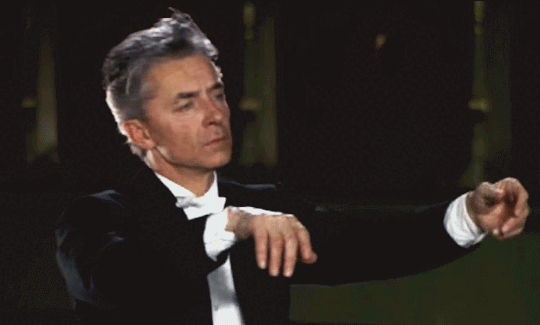
Those who have achieved all their aims probably set them too low.
- Herbert von Karajan
The Soprano Christa Ludwig described him as ‘Le bon Dieu’, while scores of musicians, reviewers and listeners have long regarded him as simply untouchable in the art of conducting. There was, however, much about Herbert von Karajan that was distinctly ungodlike. Ruthlessly ambitious as a young man and grimly autocratic in his later years, his life story is marked by bitter rivalries, feuds and, most notoriously, membership of the Nazi party.
But then, just listen to the results. It’s fascinating to look at the career, the controversy and the achievements of a conductor who still intrigues fans and detractors like no other musician long after his death.
The early career of Herbert von Karajan continues to be swathed in controversy.
Was he an ardent Nazi or an ambitious opportunist? If he was a zealous party member, should we revere his recordings as much as we do? To what extent should any moral accountability weigh against Karajan’s musical achievement? And how much latitude can we extend to people who have artistically given so generously?
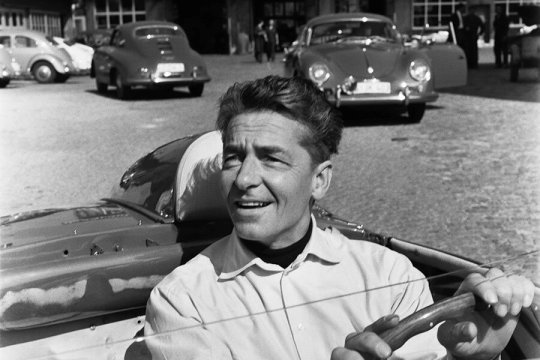
Karajan is not alone in occupying this uncomfortable situation during this era. Similar debate surrounds Richard Strauss, Carl Orff and Karl Böhm. Indeed, Wagner also evokes hostility in certain quarters with regard to his racial sentiments.
When Adolf Hitler swept to power in January 1933, the 24-year-old Austrian Herbert von Karajan had already notched up nearly four seasons as an up-and-coming opera conductor in the South German city of Ulm.
Born in Salzburg in 1908 into a prosperous family, he had demonstrated gifts as a pianist and conductor while studying in Vienna. After graduation, his debut orchestral concert with the Salzburg Mozarteum Orchestra in January 1929, featuring works by R Strauss, Mozart and Tchaikovsky, caused a local sensation and helped to secure him the contract in Ulm.
Karajan seized on the opportunity to learn his trade in Ulm and cut his teeth on much of the operatic repertory from Mozart and Beethoven to Puccini and R . Strauss, including the opera Schwanda der Dudelsacker by the Czech Jewish composer Jaromir Weinberger.
Yet, after the Nazi take-over, Karajan’s future wasn’t assured.
In early 1933, German operatic life was thrown into turmoil as the regime hounded out musicians that were deemed politically and racially unacceptable, and also pursued a protectionist policy to limit employment for non-Germans.
Against this context, Karajan’s decision to join the Nazi Party in Salzburg in April 1933 should be understood as an opportunistic move which was probably designed to safeguard his position at Ulm. Whether it also signalled enthusiasm for Nazi policy is open to speculation, though he no doubt hoped that the strong-arm methods of the Nazis would bring cultural stability to Germany.
Karajan retained his Ulm job for a further season, during which he expanded his repertory to include a praised account of Strauss’s opera Arabella. But in March 1934 he was fired for professional intrigue involving a potential Jewish rival.
He did not have to wait long for a new post. Three months later he was made general music director in Aachen.
Working in a larger theatre enabled Karajan to tackle more ambitious repertory, such as Wagner’s Ring cycle, Verdi’s Otello and Strauss’s Elektra. He also consolidated his reputation in the concert hall, taking charge of Aachen’s annual season of orchestral and choral concerts. One pre-condition for accepting was that he should re-apply for membership of the Nazi Party, his earlier membership in Salzburg having lapsed. This was confirmed in March 1935.

Although in his denazification trial in March 1946 Karajan argued that he had joined the Party to further his career, he could not escape his obligation as Aachen’s general music director to provide the musical background for political occasions.
On 29 June 1935 he took part in a huge open-air orchestral and choral concert that celebrated the NSDAP Party Day and at a similar ceremony four years later he conducted the close from Wagner’s Meistersinger. But his concert programmes seemed untainted by political interference – works by Debussy, Ravel, Kodály and Stravinsky rubbed shoulders with German ones. In 1938 he flouted the law by programming Dukas’s Sorcerer’s Apprentice. Party authorities must have overlooked that Dukas was of Jewish descent.
Karajan conducts Dvořák’s “New World” Symphony No. 9, performed by the Vienna Philharmonic Orchestra
By 1937 Karajan’s achievements in Aachen were attracting national interest.
In a special edition devoted to Germany’s conducting legacy, the journal Die Musik singled him out as a man who ‘can lead the new organisation of our cultural life in the spirit and direction which National Socialism demands’. Concert engagements in Gothenburg, Vienna, Amsterdam, Brussels and Stockholm helped to spread his name beyond Germany.
Yet for all this, Karajan set his sights even higher by hoping to make an impact in Berlin. This ambition was realised in 1938 with a ‘Strength through Joy’ concert with the Berlin Philharmonic and engagement as conductor at the Berlin State Opera in Wagner’s Tristan und Isolde in October of the same year.
Karajan may not have anticipated that with his move to Berlin he was stepping into a political cauldron over which he would have little control.
It began with a review of his Tristan which appeared in the Berliner Zeitung. Under the title ‘Karajan the Miracle’, the critic Edwin von der Nüll lavished praise on the performance suggesting that in conducting Wagner’s score from memory the 30-year-old conductor had achieved ‘something our great men in their fifties might envy’.
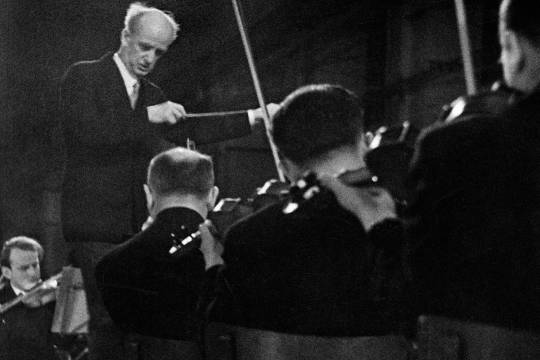
This was calculated to offend the conductor Wilhelm Furtwängler who had previously ruled the roost in the same theatre. Karajan was set up as a pawn in the struggle for control of Berlin’s cultural institutions between Propaganda Minister Joseph Goebbels, a Furtwängler supporter, and Minister of Interior Hermann Goering, the patron of the Berlin State Opera.
In June 1939 Karajan conducted Wagner’s Die Meistersinger at the State Opera without a score. The performance collapsed when the baritone, a drunk Rudolf Bockelmann, made a serious error. Alas Hitler, in the audience, was furious, blaming instead Karajan’s insufficiently Germanic approach to Wagner by conducting from memory.
Further problems arose over his marriage in 1942 to the quarter Jewish Anita Gütermann, technically against the law.
Yet, despite this and the continuing hostility and suspicion of Goebbels and Hitler and Furtwängler’s jealousy, his career prospered during the war. He conducted Bach’s B Minor Mass in Paris for the occupying German soldiers in 1940 and returned to the French capital in 1941 to present his performance of Tristan with the Berlin State Opera.
From 1940 he appeared in Italy and gave concerts in Romania and Hungary. A major achievement was to secure popularity for Orff’s Carmina Burana, a score that had aroused some hostility from the Nazi hierarchy at its first performance in 1937 before Karajan’s performances in Aachen and Berlin during the early 1940s.

Driven by a fanatical love of music and a desire to advance his career, there’s little doubt that Karajan’s involvement with the Nazi regime was opportunistic.
Doubtless though there were also areas of Nazi policy that may well have chimed in with his own views. At the same time falling foul of the regime on occasions, his personal ideology can be best described as a montage of greys; nothing is ever clear-cut and nor perhaps should be our assessment of his work.
#karajan#herbert von karajan#quote#conductor#music#german#nazi germany#nazism#opera#orchestra#classical music#history#arts#culture
37 notes
·
View notes
Text

MOZART'S FORTEPIANO
* The instrument is unsigned but can be ascribed to Anton Gabriel Walter ( 1752 - 1826 ), " organ builder and instrument maker " in Vienna.
The piano is one of Walter's oldest preserved instruments and was probably made around 1782.
* Mozarteum / Mozart Residence - Salzburg
Thank you Lisa Mirren FB @ Wolfgang Amadeus Mozart Group
#mozart#mozart life#wolfgang amadeus mozart#classical composer#classical history#classical music#classical art#classical instruments#18th century#classical#fortepiano
4 notes
·
View notes
Text

They found a new portrait of Mozart
Experts have identified the man in the painting as the musical genius Wolfgang Amadeus Mozart.
VIENNA. The identity of the young man with a round face and voluminous hairstyle in a small portrait from the 18th century no longer confuses experts - it has been confirmed that he is Wolfgang Amadeus Mozart.
Researchers from Salzburg's Mozarteum Museum have announced that they have definitively identified the person in the painting as the Austrian musical genius Mozart.
However, the likeness does not resemble his other portraits at all. Researchers say that of the 14 known paintings, this is only one of the few in which the artist looks out of the painting directly at the viewer and does not have his famous white wig.
Expert Cristoph Grosspietch says the museum's findings are based on a detailed examination of the image and historical records from the period.
#mozart#wolfgang amadeus mozart#portrait#classical art#a classical life#classical music#art#18th century#classic#classical history#classical musician#classical composer#classical
4 notes
·
View notes
Text

so so funny that when he wants to practice my cousin will close the doors to the sitting room & dining room at the b&b and then expects us not to be able to hear him, a semi-retired professional opera singer with vocal projection that he learned at the mozarteum
#he’s shy ~#it was the same when we were living in munich together when i was a kid#he’d close his door to practice (and he was quieter then bc he was training just to audition there)#but he’d leave his window open#… so my mom and i would open all the other windows too…#he has such a beautiful voice!! couldn’t resist#i was in the middle of doing room turnovers and took a break to listen 💕#personal
2 notes
·
View notes